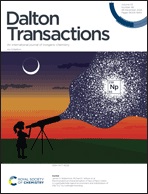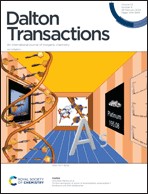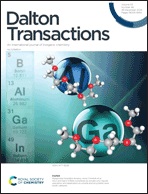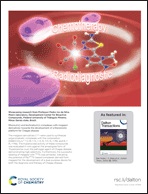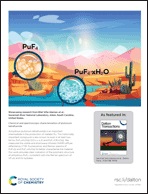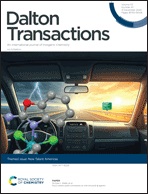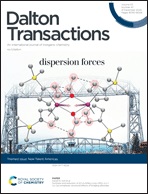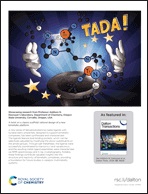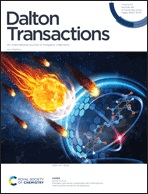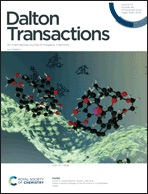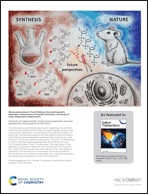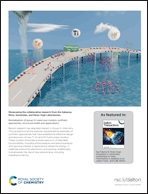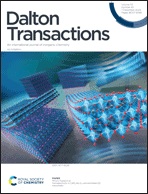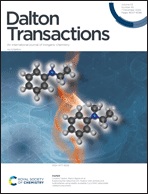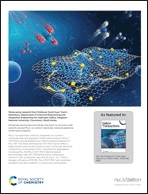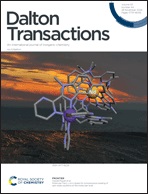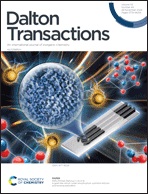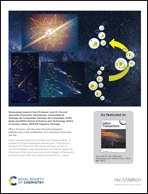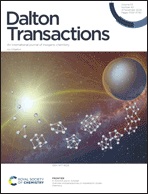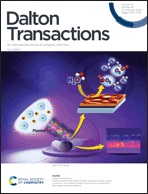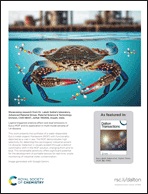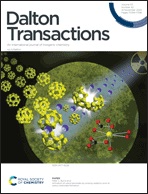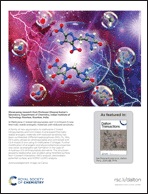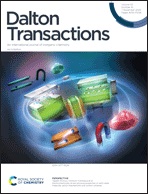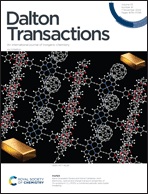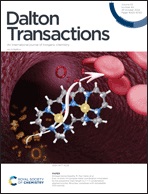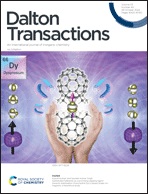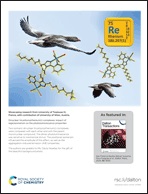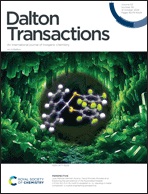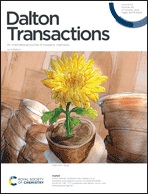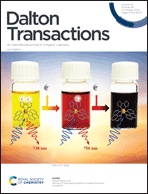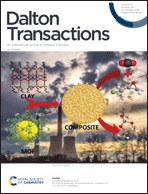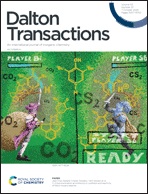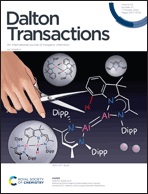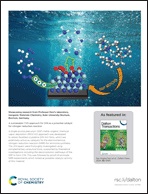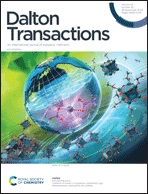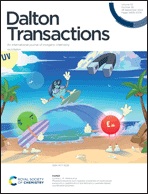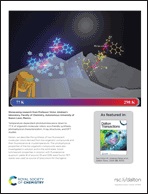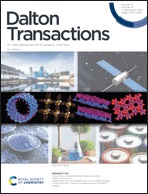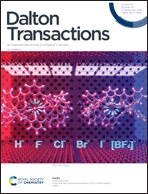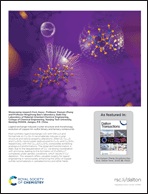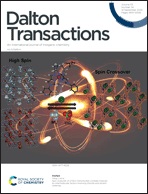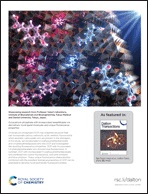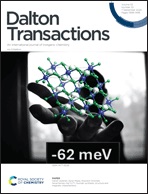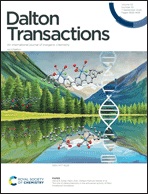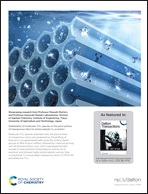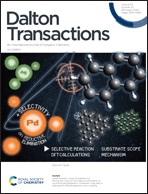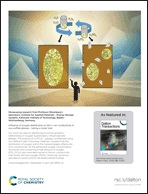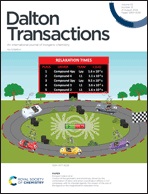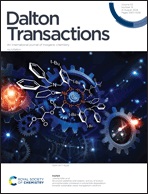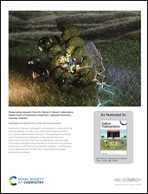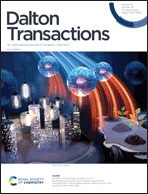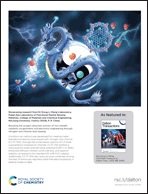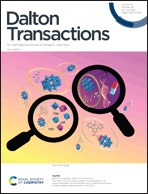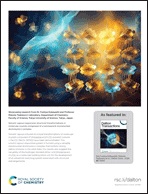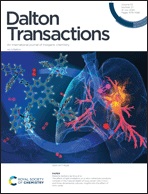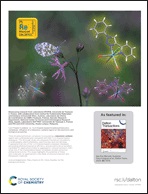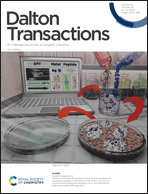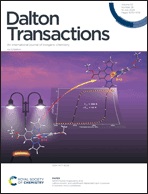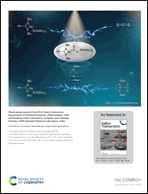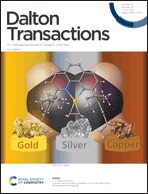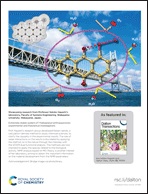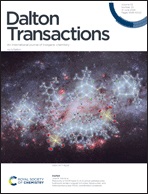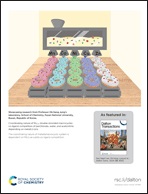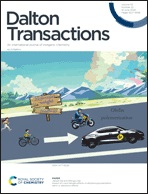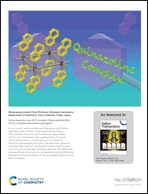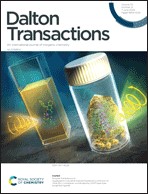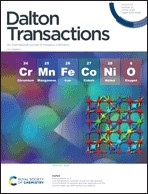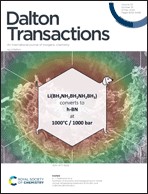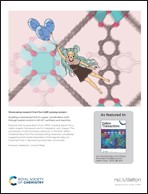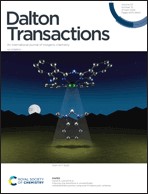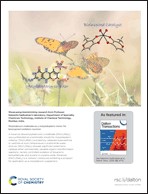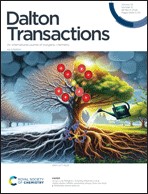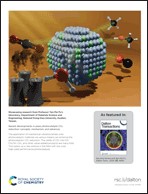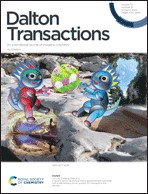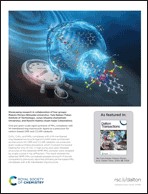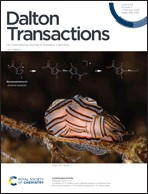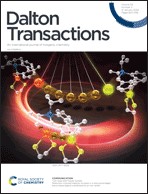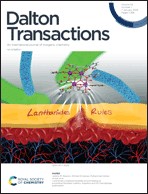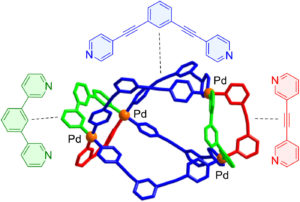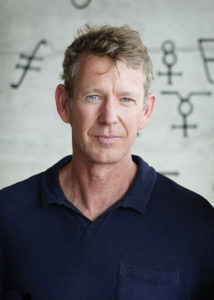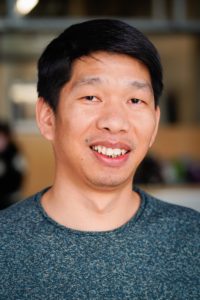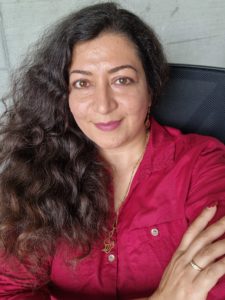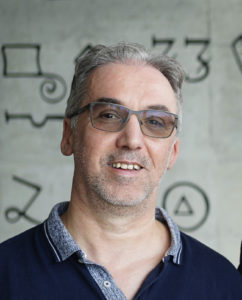Issue 48
 |
 |
 |
|
Isomeric double-cavity coordination cages: to encapsulate or not to encapsulate the guestAshish Kumar, Shobhana Krishnaswamy and Dillip Kumar Chand* Dalton Trans., 2025, 54, 17767-17771 |
Exploring the milarite minerals, Na2Mg5−xMxSi12O30 (M = Co2+, Zn2+, Ni2+, Cu2+) and Na2Mg2.5Ca0.5−xLnxZn2Si12O30 (Ln = Eu3+, Tm3+, Tb3+), towards new colored compounds, white light emission, and oxygen evolution reaction (OER) propertiesDiksha Malikab and Srinivasan Natarajan* Dalton Trans., 2025, 54, 17784-17797 |
Structurally modified dipyrazinylpyridine-based homoleptic Cu(ii) complexes: comparative cytotoxic evaluation in breast cancer cell lines
Indrajit Roy, Karthikeyan L., Sourav Deb, Sharan Shanmuga Vuppaladadium Rathnam, Jitender Jangra, Snehashish Patra, Roy Anindya and Somnath Maji* Dalton Trans., 2025, 54, 17798-17813 |
Issue 47
 |
 |
 |
|
A neutral Mn(ii)-BIF for electrocatalytic oxygen reduction reactionMinhong Li, Jingran Zhong, Chengjie Liao, Wenjuan Fan, Jin Lua Dexiang Zhang, Tian Wen* and Zhiqiang Jiang* Dalton Trans., 2025, 54, 17414-17417 |
Interplay of morphology and particle size in CuBDC MOFs governing catalytic selectivity for the efficient synthesis of 1,4-disubstituted 1,2,3-triazoles and 2-substituted quinazolinesMasshuda Madni Khatun, Priyanka Gogoi, Nilakshi Dutta, Puja Pokhrel, Diganta Sarma* and Kalyanjyoti Deori* Dalton Trans., 2025, 54, 17444-17457 |
Facile ultrasound-assisted synthesis of Cs2AgBiBr6 nanocrystals for enhanced visible-light photocatalysis (Open Access)Emmanuel Godínez, Jennyfer Moreno, Sergio Chang, Victor Hugo Guzman, Yesenia A. García-Jomaso, Herlinda Montiel, Nora S. Portillo-Vélez* and Hugo A. Lara-García* Dalton Trans., 2025, 54, 17418-17424 |
Issue 46
 |
 |
||
Induction of helical chirality in tetrahedral transition metal complexes with non-bridging monodentate oxazolines (Open Access)Marija Bakija, Berislav Perić, Tamara Rinkovec, Ernest Sanders, Zoran Kokan, Zoran Štefanić, Robert Vianello and Srećko I. Kirin* Dalton Trans., 2025, 54, 17083-17101 |
[Di(1-adamantyl)](aryl)phosphine ligands: synthesis, palladium complexation, and catalytic activity (Open Access)Chinraj Sivarajan and Raja Mitra* Dalton Trans., 2025, 54, 17073-17077 |
Issue 45
 |
 |
||
| The coordination chemistry of 2,2′-bis-p-tBu-calix[4]arene (Open Access)
Scott J. Dalgarno* and Euan K. Brechin* Dalton Trans., 2025, 54, 16643-16659 |
Selective electrochemical CO2 reduction to CO by a Co(ii) dimer catalyst by metal–ligand cooperativitySk Samim Akhter, Koushik Makhal, Dev Raj, Manaswini Raj, Thillai Natarajan M, Bhabani S. Mallik, Prabhakar Bhardwaj, Pankaj Kumar, Ebbe Nordlander and Sumanta Kumar Padhi* Dalton Trans., 2025, 54, 16682-16696 |
Issue 44
 |
 |
||
Uptake and binding of La3+ and Cr3+ ions by alkali metal substituted alpha-zirconium phosphate (Open Access)B. D. Imansha Madhushan, Adrianna L. Orsi, Jennifer M. Pyles and Jonathan D. Burns* Dalton Trans., 2025, 54, 16344-16355 |
Ligand and counter-ion effects on the photoluminescence of dinuclear bis(diphenylphosphino)amine gold(i) complexes (Open Access)Christo van Staden, Robin E. Kroon, Cameron Matthews, Lyudmila V. Moskaleva, Kgalaletso P. Otukile, Dumisani V. Kama, Marietjie Schutte-Smith and Hendrik G. Visser* Dalton Trans., 2025, 54, 16393-16409 |
Issue 43
 |
|||
Porous silica materials derived from cage-siloxane: structural confinement and stabilisation of dispersed Au(0) nanoparticles (Open Access)Takumi Masuda, Takuya Hikino, Rei Umeda, Atsushi Shimojima and Yasushi Sekine* Dalton Trans., 2025, 54, 15991-15997 |
Issue 42
 |
 |
||
Trinuclear gold chains and octanuclear copper gyrobifastigia stabilized using a fluorinated pyridyl ligandVo Quang Huy Phan, Mukundam Vanga, Benjamin T. Diroll, Alvaro Muñoz-Castro and H. V. Rasika Dias* Dalton Trans., 2025, 54, 15717-15725 |
Understanding the effect of hydrogen bonding on the structural transition and emission properties in zero-dimensional hybrid metal halides: (3,5-DMP)3BiX6 (X = Cl, Br, I)Subhasish Sahoo, Rajanikanta Rana, Chakali Srinivas, Parameswar Krishnan Iyer, Laxmipriya Dash, Himansu S. Biswal and Saroj L. Samal* Dalton Trans., 2025, 54, 15726-15744 |
Issue 41
 |
 |
 |
|
Dynamic functions of bis- and tris(saloph) cobalt(iii) structures based on axial coordinationShigehisa Akine Dalton Trans., 2025, 54, 15364-15378 |
Anti-breast cancer stem cell activity of titanocene complexes of non-steroidal anti-inflammatory drugs (Open Access)Olympia Mouriki, Ginevra Passeri, Karampal Singh, Sarah D. Lamorte, Kuldip Singh, Kogularamanan Suntharalingam* and Alexander F. R. Kilpatrick* Dalton Trans., 2025, 54, 15389-15394 |
ICG revisited: excited-state dynamics as a function of dye concentration and solvent environment (Open Access)
Maria T. Lahm, Pascal Rauthe, Kai-Ching Fan, Claus Feldmann and Andreas-Neil Unterreiner* Dalton Trans., 2025, 54, 15406-15415 |
Issue 40
 |
 |
||
On the chemistry of p-cymene ruthenium iodide complexes: entry into octahedral phenylated ruthenium(II) complexes supported by chelating bidentate N,N′-donor ligandsBrandon Quillian*, Allison Marks, Kennedy Musso, George Durrell, Joseph Bazemore, Clifford W. Padgett, Alexis Fields and Dane Zurwell Dalton Trans., 2025, 54, 15025-15042 |
X-ray crystallographic and computational studies of quaternary ammonium chloride salt complexes with uranyl–salophen compounds (Open Access)Marco Saccone*, Arto Valkonen, Kari Rissanen and Massimo Cametti* Dalton Trans., 2025, 54, 15043-15054 |
|
Issue 39
 |
 |
 |
|
Biological activities of metallic nanostructures functionalized with hexadeca-substituted copper(ii) and cobalt(ii) phthalocyaninesNazli Farajzadeh Öztürk*, Sadin Özdemir, M. Serkan Yalçın, Zehra Altuntaş Bayır* and Makbule Burkut Koçak* Dalton Trans., 2025, 54, 14664-14676 |
Proton-coupled electron transfer modulates the metal release of blood serum iron transferrinMahesh Sundararajan*, Lokpati Mishra, Naman K. Bharti and Swarna P. Mantry Dalton Trans., 2025, 54, 14677-14686 |
A highly selective Cu2+-coordination triggered multi-stimuli responsive and functional metallogel of bis-terpyridyl-based low molecular weight (LMW) gelatorPoulami Panja, Utsav Ghosh, Amit Sil and Sanjib K. Patra* Dalton Trans., 2025, 54, 14687-14700 |
 |
 |
||
IPaulHet – spatially-defined, wingtip-flexible, N,C-chelating oxazole and thiazole donor N-heterocyclic carbene ligandsPamela Podchorodecka, Błażej Dziuk, Roman Szostak, Michal Szostak* and Elwira Bisz* Dalton Trans., 2025, 54, 14267-14276 |
Circularly polarized luminescence-active low molecular weight lanthanide gels: tunable emission including white lightLoitongbam Thoithoi Singh, Ningombam Banshi Devi, Darshana Deb, Saikat Ghosh and Raju Laishram* Dalton Trans., 2025, 54, 14262-14266 |
|
 |
 |
 |
 |
Improving the dielectric temperature stability of Bi2SiO5-based ceramics through the spontaneous formation of paraelectric–ferroelectric nanocomposite structures (Open Access)Yoji Yasumoto, Taro Kuwano, Hiroki Taniguchi, Shinobu Fujihara and Manabu Hagiwara* Dalton Trans., 2025, 54, 13869-13878 |
Tetranuclear {LnIII}4 complexes possessing homometallic O-capped structural subunits: study of magnetic and photoluminescent properties (Open Access)
Purbashree Halder, Nandini Barman, Ibtesham Tarannum, Subrata Mukhopadhyay, Björn Schwarz*, Saurabh Kumar Singh* and Joydeb Goura* Dalton Trans., 2025, 54, 13879-13893 |
Electrochemical water oxidation using single-site Cu(ii) molecular complexes: a mechanism elucidated by computational studiesDev Raj, Koushik Makhal, Manaswini Raj, Aman Mishra, Rohan Mahapatra, Tanya Pattnaik, Bhabani S. Mallik and Sumanta Kumar Padhi* Dalton Trans., 2025, 54, 13894-13908 |
Advances in nano-drug delivery systems for metallic compounds in cancer therapy: challenges and future perspectivesSubin Joseph, Rinku Chakrabarty and Priyankar Paira* Dalton Trans., 2025, 54, 13820-13850 |
 |
 |
||
Reversible structural and colorimetric transitions in LuMnGaO4 upon oxygen uptake and release (Open Access)Stephanie J. Hong, Tianyu Li, H. Cein Mandujano, Alicia Manjón-Sanz, Sz-Chian Liou, Yuchen Niu and Efrain E. Rodriguez* Dalton Trans., 2025, 54, 13431-13442 |
Nonlinear optical functionalized Cu(ii) coordination complexes with chiral ligands: design, structural elucidation, and theoretical investigationNagesh Manurkar, Mubashar Ilyas, Faiza Arshad, Prasanna Patil, Qamar-Un-Nisa Tariq, Shahzad Khan, Maroof Ahmad Khan and Hui Li* Dalton Trans., 2025, 54, 13443-13458 |
|
 |
 |
 |
 |
Influence of formation temperature on the morphology of MoS2 and its catalytic properties in the hydrogenation of isomeric bromoquinolines to bromo-1,2,3,4-tetrahydroquinolinesAnastasia V. Terebilenko, Maryna V. Olenchuk, Denys O. Mazur, Andrii S. Nikolenko, Vadym I. Popenko, Galyna I. Dovbeshko, Oleksii Bezkrovnyi, Tomash Sabov, Boris M. Romanyuk, Volodymir N. Poroshin, Serhiy V. Ryabukhin, Dmytro M. Volochnyuk and Sergey V. Kolotilov* Dalton Trans., 2025, 54, 13057-13070 |
Isostructural Mg and Zn compounds: analogies and differences in reactivity (Open Access)Kriti Pathak, Suban Kundu, Sheetal Kathayat Bisht and Ajay Venugopal* Dalton Trans., 2025, 54, 13005-13019 |
Amplification of luminescence intensity by ytterbium(iii) dopant in upconversion nanoparticles integrated with carbon dots for NIR-responsive targeted photodynamic therapyBijay Saha, Antara Ghosh, Archana Singh and Sumanta Kumar Sahu* Dalton Trans., 2025, 54, 13071-13084 |
Nitrated triarylphosphine oxides: accessible triarylphosphoryl molecules with up to six nitro groups (Open Access)Rafael Pérez, Houari Dahmani and Guillaume Bélanger-Chabot* Dalton Trans., 2025, 54, 13030-13034 |
 |
 |
||
A strongly hydrogen-bonded one-dimensional high-spin dinuclear Fe(ii) complexHoa Phan*, Kieu Thuy Thi Thai, Nobuto Funakoshi, Huyen Thu Thi Tran, Masahiro Yamashita and Michael Shatruk* Dalton Trans., 2025, 54, 12749-12753 |
Silver dithiocarbamates derived from amino acid esters (Open Access)Vreni Behling, Jakob Heinrich, Dolores Díaz, Elias H. P. Brohmer, Julian Heinrich, Nils Schlörer, Stephan Kupfer, Nora Kulak and Phil Köhler* Dalton Trans., 2025, 54, 12772-12783 |
|
 |
|||
Discrete inorganic molecular upconversion: a dinuclear ytterbium–polyoxometalate complex exhibits cooperative upconversion luminescenceRyunosuke Karashimada*, Motoki Nakahara and Nobuhiko Iki* Dalton Trans., 2025, 54, 12443-12446 |
|
|
 |
 |
||
Stabilization of the garnet lattice by silicon incorporation in polycrystalline katoite (Open Access)Artem Shevchenko, Keshia Morell, Igor Moudrakovski, Bettina Lotsch, Robert Dinnebier and Sebastian Bette* Dalton Trans., 2025, 54, 12157-12168 |
Shrinking of C–S bonds of organosulfonic acids in superacidic media—investigation of the protonation of methanesulfonic acid and benzenesulfonic acid and their limits (Open Access)Valentin Bockmair*, Tong Xu, Dirk Hollenwäger and Andreas J. Kornath* Dalton Trans., 2025, 54, 12169-12179 |
|
 |
 |
||
Atomically precise noble metal nanoclusters for engineering self-assembled two-dimensional materials (Open Access)Venishaa Sethumadhavan and Nonappa* Dalton Trans., 2025, 54, 11770-11789 |
Unlocking the potential of pyridazine: a promising backbone for high-energy density compoundParasar Kumar, Shreyasi Banik and Srinivas Dharavath* Dalton Trans., 2025, 54, 11790-11800 |
|
 |
 |
 |
|
Co-doped vanadium nitride/carbon composite fabricated from cobalt–vanadium metal–organic framework precursors for supercapacitorsYongtao Tan*, Fengwei Tuoa and Yuan Zhang Dalton Trans., 2025, 54, 11505-11515 |
Electronic structure regulation in medium-entropy CoNiFeSe enabling efficient and durable oxygen evolution electrocatalysisYu-Xin Luan, De-Kun Liu, Yu-Xiang Chen, Xue-Zhi Song*, Jing Liang,* Xiao-Bing Wang, Wen-Qiang Sun, Yu-Lan Meng, Chen-Yu Shen, Ruichen Zhou, Jinxuan Liu, Xiao-Feng Wang* and Zhenquan Tan* Dalton Trans., 2025, 54, 11516-11524 |
Unquenched orbital angular momentum in quasi-linear two-coordinate transition metal complexes featuring sterically bulky carbazole ligandsSadia Noor, Samantha Stegman, Jacob B. Palmer and Brian S. Dolinar* Dalton Trans., 2025, 54, 11495-11499 |
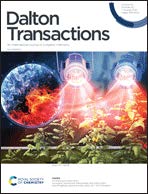 |
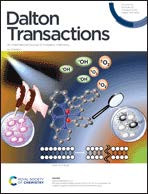 |
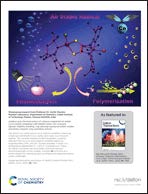 |
|
Synergistic luminescent thermometer and indoor plant growth lighting utilizing the Mg2LaSbO6:Eu3+/Mn4+ phosphorFei Wang* and Huihui Chen Dalton Trans., 2025, 54, 11162-11173 |
Photoactivated antibacterial activity of Fe(iii) complexes via singlet oxygen-mediated bacterial membrane lysisIshwar Singh, Rohit Rai, Rajesh Kushwaha, Prodyut Dhar* and Samya Banerjee* Dalton Trans., 2025, 54, 11174-11181 |
Isolation and characterization of carbene-supported air stable Co(ii)-radical complexes with bileptic redox non-innocent ligands: stability, bonding, ring-opening copolymerization studies and photo-catalytic ring cyclization activitySujit Das, Sangita Mondal, Sonam Suthar, Ranay Kumar Ray, Karunamayee Mondal, Avany A. Raveendran, Subuhan Ahamed, Chandan Maji,a Mahiuddin Baidya*, Björn Schwarz*, Debashis Chakraborty*, Liviu Ungur* and Kartik Chandra Mondal* Dalton Trans., 2025, 54, 11182-11192 |
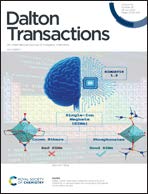 |
 |
||
SIMDAVIS 1.2: phosphonates are outstanding SIM ligands. Crown ethers are notWalter Cañón-Mancisidor*, Christopher González Ponce, Lorena E. Rosaleny and Alejandro Gaita-Ariño Dalton Trans., 2025, 54, 10873-10882 |
2D borophene: An emerging material for supercapacitor applicationsGopinath Sahoo, Sang Mun Jeong* and Chandra Sekhar Rout Dalton Trans., 2025, 54, 10847-10861 |
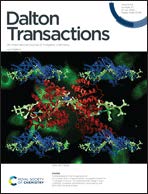 |
|||
p-Cymene–Ru(ii)–organometallic conjugates based on ‘V-shaped’ 4-amino-1,8-naphthalimide Tröger’s base scaffolds: synthesis, photophysics, bioimaging, and BSA/HSA binding studies (Open Access)Binduja Mohan, Anna Jose, Indrajit Bhattacharjee, Raju Saravanan, Mannanthara Kunhumon Noushija, Mintu Porel, Bibhu Ranjan Sarangi and Sankarasekaran Shanmugaraju Dalton Trans., 2025, 54, 10549-10557 |
|
 |
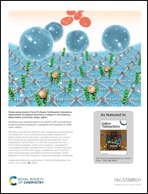 |
||
Facilitated phase transformation of CaAl2Si2O8 by kaolinite-derived aluminosilicate nanoscrollsShingo Machida*, Hajime Okawa, Masaya Suzuki and Toshimichi Shibue Dalton Trans., 2025, 54, 9866-9876 |
Synthesis and characterisation of uniform CoPt nanoparticles using red blood cell ghosts conjugated with peptides on their inner surfaceShota Matsumoto, Zhang Yiyang, Nobuto Yoshinari, Kazuma Yasuhara, Masaaki Ohba and Tomomi Koshiyama* Dalton Trans., 2025, 54, 9856-9860 |
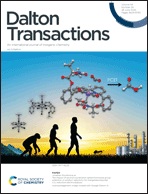 |
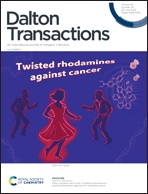 |
||
The impact of second coordination sphere functional group extension on product selectivity for manganese bipyridyl CO2 reduction electrocatalysts (Open Access)Lisa Suntrup, Vanna Blasczak, Roonak Saeedi, Mehmed Z. Ertem and Jonathan Rochford* Dalton Trans., 2025, 54, 9494-9502 |
Metal complexes with a twist: modified rhodamines as a promising theranostic approach for combating cancer (Open Access)Fábio Martins, Maria G. P. M. S. Neves and Ana M. G. Silva* Dalton Trans., 2025, 54, 9472-9482 |
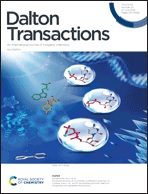 |
|||
Structural diversity of nucleotide coordination polymers of cytidine mono-, di-, and tri-phosphates and their selective recognition of tryptophan and tyrosineYaqoot Khan, Yunyun Du, Li Yan, Niu Zhang, Menglei Zhang, Hongwei Ma*and Hui Li* Dalton Trans., 2025, 54, 9145-9159 |
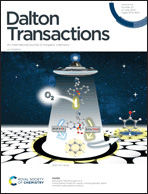 |
|||
A bioinspired model for copper monooxygenase: direct aromatic hydroxylation using O2Ramamoorthy Ramasubramanian, Karunanithi Anandababu, Mukesh Kumar and Ramasamy Mayilmurugan* Dalton Trans., 2025, 54, 8788-8799 |
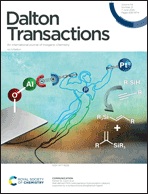 |
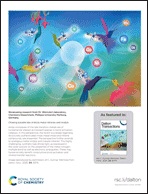 |
||
Well-defined Pt(0) heterogeneous hydrosilylation catalysts supported by a surface bound phosphenium ligandDamien B. Culver*, Marco Mais, Min-Chul Kang, Lin Zhou and Frédéric A. Perras* Dalton Trans., 2025, 54, 8392-8399 |
Chasing isolable late d-block metal nitrenes and imidyls (Open Access)
C. Gunnar Werncke* Dalton Trans., 2025, 54, 8374-8384 |
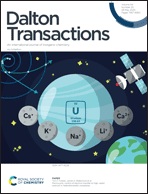 |
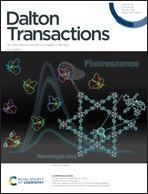 |
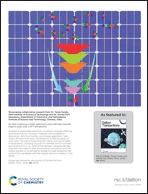 |
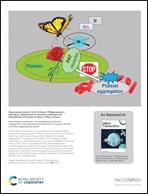 |
Macrocyclic control of electron transfer to high valent uranium in heterobimetallic complexes (Open Access)Amit Kumar, Riddhi R. Golwankar, Mikaela M. F. Pyrch, Fynn L. Cooper, Grant A. Arehart, Korey P. Carter, Allen G. Oliver, Victor W. Day, Tori Z. Forbes* and James D. Blakemore* Dalton Trans., 2025, 54, 8061-8075 |
Selective detection of SO2 in NU-1000 via organometallic nickel silylphosphine post-synthetic complex incorporation (Open Access)Juan L. Obeso, Luz J. Barrios-Vargas, Valeria B. López-Cervantes, Yoarhy A. Amador-Sánchez, Nancy Martin-Guaregua, Ricardo A. Peralta, Ramon Munoz, Ana Martínez, Carolina Leyva, Diego Solis-Ibarra, Elí Sánchez-González*, Ilich A. Ibarra* and Virginia Montiel-Palma* Dalton Trans., 2025, 54, 8029-8034 |
Six-fold screening unfolds optimized rylene diimides towards organic solar cells: a DFT perspectiveSri Vanaja, Tanay Kundu* and Amrita Pal* Dalton Trans., 2025, 54, 8076-8085 |
Metal-based complexes with antiplatelet properties: antagonists of the platelet-activating factor receptor (PAFR) and other aggregating agents (Open Access)Athanassios I. Philippopoulos* and Constantinos A. Demopoulos Dalton Trans., 2025, 54, 8015-8028 |
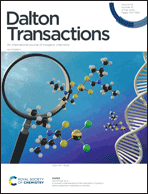 |
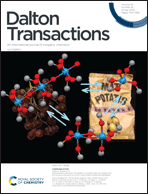 |
 |
|
A revised understanding of the speciation of gold(iii) dithiocarbamate complexes in solution (Open Access)Ryan K. Brown, Joseph N. Bunyan, Ashi Agrawal, Guoyu Li, Dominykas Dautoras, Jagodish C. Sarker, Terng Tor Keat, Thomas Hicks, Graeme Hogarth and David Pugh* Dalton Trans., 2025, 54, 7627-7640 |
Polymerisation isomerism of tungsten(vi) oxomethoxide: new insights into the structure and reactivity of non-cluster metal oxoalkoxide aggregates (Open Access)Gulaim A. Seisenbaeva, Lars Kloo, Peter Agback and Vadim G. Kessler* Dalton Trans., 2025, 54, 7611-7615 |
Exploring the synthesis of Ru(ii)/Ir(iii)/Re(i)/Rh(iii)-based complexes as anticancer metallopharmaceuticals: significance, challenges and future perspectiveSreelekha U, Rinku Chakrabarty* and Priyankar Paira* Dalton Trans., 2025, 54, 7602-7610 |
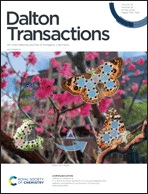 |
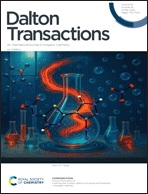 |
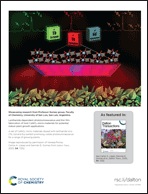 |
|
C–C bond-forming reactions of 2-isocyanobiphenyl·BX3 adducts: spontaneous construction of polycyclic heteroaromaticsYu-Tsen Kuo, Chia-Yu Yao, Yi-Hung Liu, Mu-Jeng Cheng and Jeffrey M. Farrell* Dalton Trans., 2025, 54, 7189-7193 |
Exploring new frontiers: alliance of pyrazole and thiadiazole in energetic materialsParasar Kumar, Vikas D. Ghule and Srinivas Dharavath* Dalton Trans., 2025, 54, 7194-7197 |
Lanthanide-dependent photoluminescence and thin film fabrication of host CaWO4 micro-materials for potential indoor plant growth applicationsVanesa Ponce, Rik Van Deun, Liliana P. Fernández, Griselda E. Narda, Carlos A. López* and Germán E. Gomez* Dalton Trans., 2025, 54, 7252-7262 |
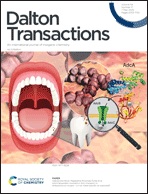 |
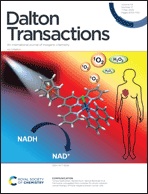 |
||
AdcA lipoprotein involved in Zn(ii) transport in Streptococcus mutans – is it as metal-specific as expected?Kinga Garstka, Aleksandra Hecel*, Henryk Kozłowski, Alicia Dominguez-Martin, Krzysztof Szewczyk and Magdalena Rowińska-Żyrek* Dalton Trans., 2025, 54, 6795-6804 |
Ferrocene conjugated Os(ii) complex for photo-catalytic cancer therapy of triple-negative breast cancer cellsApurba Mandal, Virendra Singh, Silda Peters, Arif Ali Mandal, Tumpa Sadhukhan*, Biplob Koch* and Samya Banerjee* Dalton Trans., 2025, 54, 6785-6789 |
|
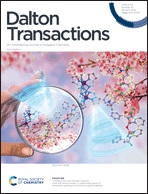 |
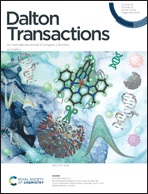 |
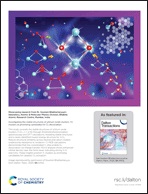 |
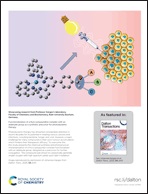 |
Axial and helical chirality in multinuclear group 13 complexes: pathways to functional optical materials (Open Access)Toshikazu Ono* and Yousuke Ooyama* Dalton Trans., 2025, 54, 6361-6368 |
Benzimidazole-based mononuclear polypyridyl Cu(ii) complexes: DNA binding, cleavage, and in vitro antiproliferative studiesIndrajit Roy, Shobhit Mathur, Sourav Deb, Sharan Shanmuga Vuppaladadium Rathnam, Nikhil Tuti, Unnikrishnan Paruthiyezhath Shaji, Karthikeyan L, Anindya Roy and Somnath Maji* Dalton Trans., 2025, 54, 6386-6401 |
Investigating the stable structures of yttrium oxide clusters: Yn clusters as promising candidates for O2 dissociationVarun Vinayak Deshpande, Debashis Bandyopadhyay, Vaibhav Chauhan, Gayatri Kumari and Soumen Bhattacharyya* Dalton Trans., 2025, 54, 6402-6410 |
Functionalization of a Ru(ii) polypyridine complex with an aldehyde group as a synthetic precursor for photodynamic therapy (Open Access)Lisa-Marie Servos, Hung Manh Tran, Nicolás Montesdeoca, Zisis Papadopoulos, Eun Sakong and Johannes Karges* Dalton Trans., 2025, 54, 6411-6418 |
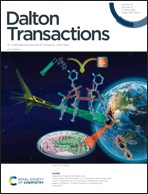 |
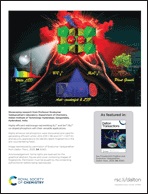 |
||
Tetranuclear and dinuclear Cu(ii) complexes with risedronate as anti-Trypanosoma cruzi and anti-Leishmania mexicana agents. Synthesis, crystal structures, and biological evaluation (Open Access)Miguel Á. Romero-Solano, Eya Caridad Rodríguez-Pupo, Ignacio Martinez, Berenice Prestegui-Martel, Alberto Martínez-Muñoz, Bertha Espinoza*, Diego Martínez-Otero, Víctor López-Guerrero, Alma K. Esteban Covarrubias and Alejandro Dorazco-González* Dalton Trans., 2025, 54, 6043-6059 |
Highly efficient red/orange-red emitting Eu3+ and Sm3+/Eu3+ co-doped phosphors with their versatile applicationsPriyadarshini Pradhan and Sivakumar Vaidyanathan* Dalton Trans., 2025, 54, 6060-6080 |
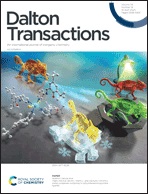 |
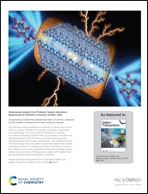 |
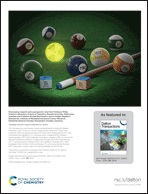 |
|
Triple-chromic (photo-, thermo-, and mechano-chromic) metal complexes containing N-salicylideneaminopyridine ligands (Open Access)Haruki Sugiyama, Atsuko Arita, Akiko Sekine and Hidehiro Uekusa* Dalton Trans., 2025, 54, 5668-5674 |
Acceptorless oxidant-free dehydrogenation of amines catalyzed by Ru–hydride complexes of amide-acid/ester ligandsSamanta Yadava and Rajeev Gupta* Dalton Trans., 2025, 54, 5675-5684 |
Targeted bismuth-based materials for cancer (Open Access)
Amna Batool, Ina Kopp, Manja Kubeil, Michael Bachmann*, Philip C. Andrews* and Holger Stephan* Dalton Trans., 2025, 54, 5614-5639 |
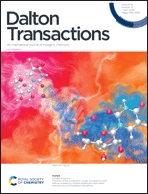 |
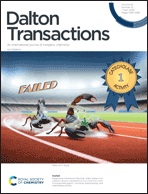 |
||
Transition of the coordination modes in sodiated uridine radicals revealed by infrared multiphoton dissociation spectroscopy and theoretical calculationsKairui Yang, Min Kou, Zicheng Zhao, Jinyang Lia and Xianglei Kong* Dalton Trans., 2025, 54, 5259-5267 |
Cationic−anionic complexes of Cu(ii) and Co(ii) with N-scorpionate ligand – structure, spectroscopy, and catecholase activity (Open Access)Małgorzata Zienkiewicz-Machnik*, Roman Luboradzki, Justyna Mech-Piskorz, Gonzalo Angulo, Wojciech Nogala, Tomasz Ratajczyk, Pavlo Aleshkevych and Adam Kubas* Dalton Trans., 2025, 54, 5268-5285 |
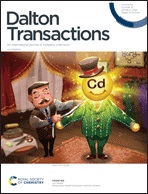 |
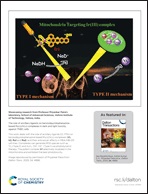 |
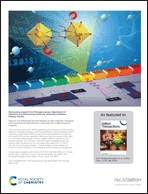 |
|
Bisquinoline-based fluorescent cadmium sensorsYuji Mikata* Dalton Trans., 2025, 54, 4848-4855 |
The role of ancillary ligands on benzodipyridophenazine-based Ru(ii)/Ir(iii) complexes in dark and light toxicity against TNBC cellsNivedya T., Rishav Das, Selva Kumar R., Shanooja Shanavas, Bhaskar Rangaswamy, Mujthaba Aatif A, Chandrapaul Mukherjee, Riona Roy, Jhimli Sengupta, Bipasha Bose*, Ashok Kumar S. K.* and Priyankar Paira* Dalton Trans., 2025, 54, 4888-4902 |
Impacts of β-diketonate terminal ligands on slow magnetic relaxation and luminescence thermometry in dinuclear DyIII single-molecule magnetsAirton Germano Bispo-Jr, Diogo Alves Gálico, Jeffrey S. Ovens, Fernando Aparecido Sigoli* and Muralee Murugesu* Dalton Trans., 2025, 54, 4876-4887 |
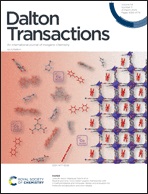 |
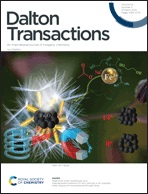 |
||
Neutral and ionic Co(ii) metal–organic frameworks with 2-methylimidazole and trimesate: design and evaluation for molecule encapsulation and slow release (Open Access)Jose de Jesus Velazquez Garcia*, Luis de los Santos Valladares, Crispin H. W. Barnes, Sandra König, Michael Fröba, Volodymyr Baran, Bassima Knjo, Faegheh Khademhir, Aliyenur Ekineken, Fabienne Hain, Evke Carstensen, Tom Spillner, Lina Asprilla Herrera, Weronika Łukaszczyk and Simone Techert Dalton Trans., 2025, 54, 4449-4460 |
Heat-generation behavior of Fe3O4 particles in AC magnetic fields: analysis of microstructures through tiltingManas Srivastava, Ruchi Agrawal, Atom Rajiv Singh, Leishangthem Sanatombi Devi, Rashmi Joshi, Bheeshma Pratap Singh*, D. Sarkar, Rakesh Kumar Singhal and Raghumani Singh Ningthoujam* Dalton Trans., 2025, 54, 4461-4473 |
 |
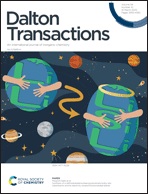 |
||
Copper coordination chemistry of the patellamides – cyanobactins in the ascidian-Prochloron symbiosis (Open Access)Philipp Baur* and Peter Comba* Dalton Trans., 2025, 54, 3968-3976 |
Synthesis of a dilithiobutadiene bearing extremely bulky silyl substituents and its reactivity toward functionalized silanesKatharina Münster, Shunsuke Kudo, Takuya Kuwabara, Eriko Shimamura, Shunsuke Furukawa, Yusuke Yoshida, Shintaro Ishida, Takeaki Iwamoto, Kazuki Tanifuji, Yasuhiro Ohki, Mao Minoura and Masaichi Saito* Dalton Trans., 2025, 54, 4030-4038 |
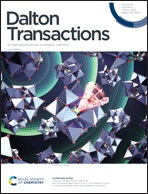 |
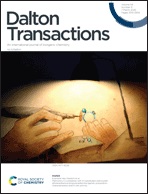 |
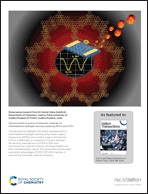 |
|
Spin coherence phenomena of an S = 1/2 copper(ii) system in a polyoxometalate with a less-abundant nuclear spinToshiharu Ishizaki*, Mizue Asada, Toshikazu Nakamura and Tomoji Ozeki* Dalton Trans., 2025, 54, 3581-3585 |
Platinum(ii/iv) complexes with N-substituted carboxylate ethylenediamine/propylenediamine ligands: preparation, characterization and in vitro activity (Open Access)Stefan Richter, Peter Lönnecke, Dijana Bovan, Nicoleta Andrian, Bianca Stoean, Maria Lehene, Radu Silaghi-Dumitrescu, Luiza Gaina, Sanja Mijatović, Danijela Maksimović-Ivanić, Goran N. Kaluđerović and Evamarie Hey-Hawkins* Dalton Trans., 2025, 54, 3597-3609 |
Advancements in porous framework materials for chemiresistive hydrogen sensing: exploring MOFs and COFsNany Thokala, Marilyn Esclance DMello, Krishnaveni Valle, Kiran Vankayala and Suresh Babu Kalidindi* Dalton Trans., 2025, 54, 3526-3550 |
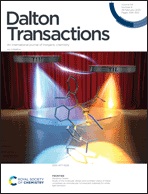 |
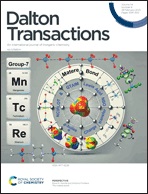 |
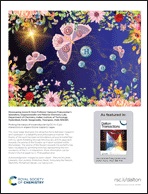 |
|
Study of the molecular design and synthesis status of metal complexes as unimolecular luminescent materials for white light emissionMasahisa Osawa* Dalton Trans., 2025, 54, 3106-3112 |
The matere bond (Open Access)Rosa M. Gomila and Antonio Frontera* Dalton Trans., 2025, 54, 3095-3105 |
Probing the nature of intramolecular (sp3)C–H⋯Cu(i) interactions in organo thione copper(i) cagesGirbide Amitkumar Ramakant, Gopendra Muduli, Rakesh Kumar Rai and Ganesan Prabusankar* Dalton Trans., 2025, 54, 3118-3126 |
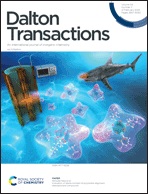 |
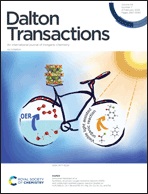 |
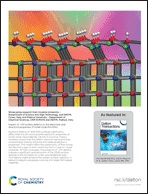 |
|
Evaluation of dipole moment of polyhedral oligomeric silsesquioxane compoundsNaoki Watanabe, Hiroaki Imoto and Kensuke Naka* Dalton Trans., 2025, 54, 2747-2752 |
Synthesis, structure, oxygen evolution reaction (OER) and visible-light assisted organic reaction studies on A2M2TeB2O10 (A = Ba and Pb; M = Mg, Zn, Co, Ni, Cu, and Fe)Indrani G. Shanmugapriya, Shreenibasa Sa and Srinivasan Natarajan* Dalton Trans., 2025, 54, 2753-2764 |
Impact of –OH surface defects on the electronic and structural properties of nickel oxide thin films (Open Access)Ettore Fois, Chiara Maccato, Davide Barreca*, Cristiano Invernizzi and Gloria Tabacchi* Dalton Trans., 2025, 54, 2765-2775 |
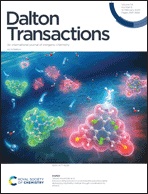 |
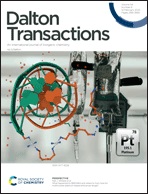 |
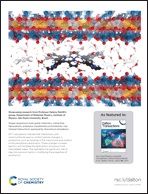 |
|
| Emission enhancement in a luminescent polychlorinated diphenylpyridylmethyl radical through coordination to silver(i)
Takuto Mibu,* Ryota Matsuoka, Masanari Nagasaka and Tetsuro Kusamoto* Dalton Trans., 2025, 54, 2265-2270 |
What happened to BBR3464 and where to from here for multinuclear platinum-based anticancer drugs?Mia A. Tesoriero and Nial J. Wheate* Dalton Trans., 2025, 54, 2199-2208 |
Shape-responsive host–guest chemistry: metal-free tetracationic porphyrin nonplanarity promoted by clay mineral interactions assessed by theoretical simulationsEduardo Diaz Suarez, Filipe Camargo Dalmatti Alves Lima, Arles V. Gil Rebaza, Vera Regina Leopoldo Constantino* and Helena Maria Petrilli* Dalton Trans., 2025, 54, 2271-2282 |
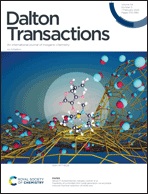 |
 |
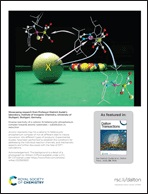 |
|
Feasibility of controlled nitric oxide generation via ascorbate induced chemical reduction of nitrite ions (Open Access)Hannah J. Naldrett, Csilla Fekete, Robert H. Bartlett, Zoltán Benkő, Steven P. Schwendeman* and Gergely Lautner* Dalton Trans., 2025, 54, 1797-1805 |
Metal complex-based probes for the detection of chloride ionsBishnu Das* and Sanwayee Biswas Dalton Trans., 2025, 54, 1731-1749 |
Diverse reactivity of a cationic N-heterocyclic phosphenium complex towards anionic substrates – substitution vs. reduction (Open Access)Christoph M. Feil, Florian Goerigk, Yannick Stöckl, Martin Nieger and Dietrich Gudat* Dalton Trans., 2025, 54, 1806-1814 |
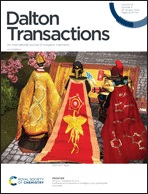 |
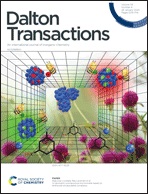 |
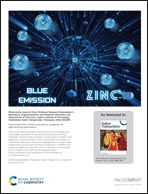 |
|
Syntheses and properties of energetic cyclo-pentazolate cocrystalsFanle Meng, Zihong Ye, Hongwei Zhu, Lianghe Sun, Ming Lu* and Yuangang Xu* Dalton Trans., 2025, 54, 1307-1319 |
A ratiometric luminescence thermometer based on lanthanide encapsulated complexesAribam Rishikanta Sharma, Atom Rajiv Singh, Anju Ajayan Kongasseri, Swadhin Garain, Ann Mariella Babu, Rajkumari Lonibala* and Raju Laishram* Dalton Trans., 2025, 54, 1377-1383 |
Fluorescent zinc(ii) thione and selone complexes for light-emitting applicationsSuman Mandal, Bikash Lahkar, Gopendra Muduli, Arushi Rawat, Abhilash Sahu, Osamu Tsutsumi and Ganesan Prabusankar* Dalton Trans., 2025, 54, 1384-1392 |
 |
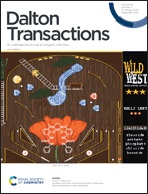 |
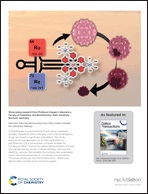 |
|
Interfacing CuO, CuBi2O4, and protective metal oxide layers to boost solar-driven photoelectrochemical hydrogen evolution (Open Access)Cathal Burns, Owen Woodford, Susanna L. Stephens, Muhammed Rishan, Linsey Fuller, Shafeer Kalathil* and Elizabeth A. Gibson* Dalton Trans., 2025, 54, 920-933 |
Synthesis and anion binding properties of (thio)urea functionalized Ni(ii)-salen complexesJae Elise L. Payong, Nadia G. Léonard, Lauren M. Anderson-Sanchez, Joseph W. Ziller and Jenny Y. Yang* Dalton Trans., 2025, 54, 934-941 |
Necrosis inducing tetranuclear Ru(ii)–Re(i) metal complex for anticancer therapy (Open Access)Julia Schleisiek, Eleni Michaltsis, Stephan Mayer, Nicolás Montesdeoca and Johannes Karges* Dalton Trans., 2025, 54, 942-950 |
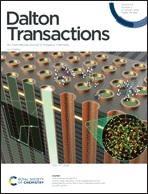 |
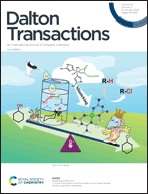 |
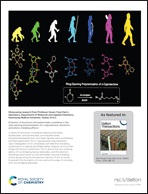 |
|
Atomic layer deposition of Sn-doped germanium diselenide for an As-free Ovonic threshold switch with low off-currentByongwoo Park, Jeong Woo Jeon, Woohyun Kim, Wonho Choi, Gwang Sik Jeon, Sangmin Jeon, Sungjin Kim, Chanyoung Yoo, Junyoung Lim, Yonghun Sung, David Ahn and Cheol Seong Hwang* Dalton Trans., 2025, 54, 492-502 |
C–H bond chlorination and bromination using water soluble nickel(ii) guanidine complexesJaipriya Khatri, Vasanthapandiyan Mari, Aniruddha Sarkar, Naiwrit Karmodak and Basab Bijayi Dhar* Dalton Trans., 2025, 54, 503-510 |
Evolution of aluminum aminophenolate complexes in the ring-opening polymerization of ε-caprolactone: electronic and amino-chelating effectsPrasanna Kumar Ganta, Fei Huang, Taoufik Ben Halima, Rajiv Kamaraj, Yu-Ting Chu, Hsi-Ching Tseng, Shangwu Ding, Kuo-Hui Wu* and Hsuan-Ying Chen* Dalton Trans., 2025, 54, 511-532 |
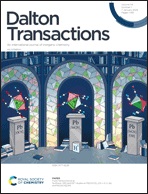 |
|||
Synthesis, XRD and DFT studies on Pb[ChCN]2 (Ch = O, S, Se) and Pb[SeCN][OH] (Open Access)Alena Shlyaykher, Aleksandar Živković, Hennes Günther, Anna Lea Barba, Nora H. de Leeuw and Frank Tambornino* Dalton Trans., 2025, 54, 74-88 |
|


























